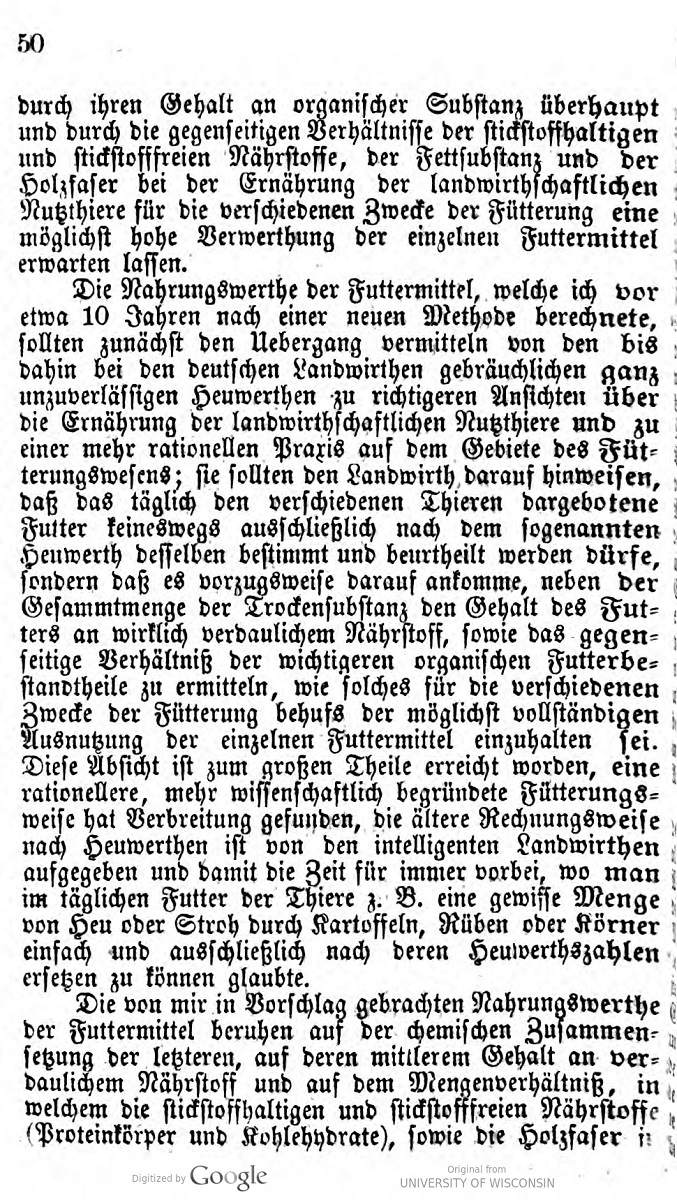Wolff’s justification for omitting hay values

Annotation
In 1864, for the first time, Emil Wolff did not include hay values alongside nutritional components in the data tables published annually in the calendar. In this accompanying article, Wolff reframed his previous translation into hay values as merely educational. The contrast between the hay values and the nutritional values had been intended to transition farmers to the correct system of nutritional values. Instead of hay values, Wolff added columns for the nutritional values of phosphoric acid and calcium oxide, minerals which scientists could now detect in chemical analysis and found to be important in nutrition. Scientific complexity replaced ease of use. He explained this decision as the result of the complexity that scientific research had found in the subject of animal nutrition. Improvements in chemical analysis and new experimental findings about nutrient digestibility, especially in certain nutrient combinations, made the compromise of single equivalent values between feeds impossible. He essentially told improvers that scientists’ knowledge had superseded theirs irreversibly.
His description that “intelligent” farmers had adopted his scientific feeding method was less a description of reality but an implicit threat. If farmers rejected scientific feeding, they were backward and stubborn conservatives of yesteryear. Scientists frequently identified farmers who used their suggested methods as intelligent, progressive, turned towards the future. Using scientific methods became a form of distinction. If farmers decided to use scientific methods and could even afford to do so, they were better than their neighbors who did not.
In truth, however, few “intelligent” farmers had yet transitioned when Wolff proclaimed it a fait accompli in 1864. His statement was more a strategy to claim authority than a description of fact. It expressed scientists’ worldview in which only science could provide the answers improvers needed. When Wolff proclaimed the hay values a thing of the past, the improver editor of the calendar, Oscar Mentzel, included them right underneath Wolff’s tables at least until 1869. He anticipated the demands of his audience. It was a slower and more contested transition than Wolff made it out to be.
This source is part of the teaching module on agricultural knowledge in the late nineteenth century.
Text
Die Nahrungswerthe der Futtermittel, welche ich vor etwa 10 Jahren nach einer neuen Methode berechnete, sollten zunächst den Uebergang vermitteln von den bis dahin bei den deutschen Landwirthen gebräuchlichen ganz unzuverlässigen Heuwerthen zu richtigeren Ansichten über die Ernährung der landwirthschaftlichen Nutztiere und zu einer mehr rationellen Praxis auf dem Gebiete des Fütterungswesens; sie sollten den Landwirth darauf hinweisen, daß das täglich den verschiedenen Thieren dargebotene Futter keineswegs ausschließlich nach dem sogenannten Heuwerth desselben bestimmt und beurtheilt werden dürfe, sondern daß es vorzugsweise darauf ankomme, neben der Gesammtmenge der Trockensubstanz den Gehalt des Futters an wirklich verdaulichem Nährstoff, sowie das gegenseitige Verhältnis der wichtigeren organischen Futterbestandtheile zu ermitteln, wie solches für die verschiedenen Zwecke der Fütterung behufs der möglichst vollständigen Ausnutzung der einzelnen Futtermittel einzuhalten sei. Diese Absicht ist zum großen Theile erreicht worden, eine rationellere, mehr wissenschaftlich begründete Fütterungsweise hat Verbreitung gefunden, die ältere Rechnungsweise nach Heuwerthen ist von den intelligenten Landwirthen aufgegeben und damit die Zeit für immer vorbei, wo man im täglichen Futter der Thiere z.B. eine gewisse Menge von Heu oder Strog durch Kartoffeln, Rüben oder Körner einfach und ausschließlich nach deren Heuwerthszahlen ersetzen zu können glaubte.
Translation
The nutritional values of feedstuffs, which I calculated according to a new method about 10 years ago, were supposed to communicate the transition from the completely unrealiable hay values commonly used until then by German farmers to more correct views on the nutrition of agriculturally productive livestock and to a more rational practice in the area of feeding; they were supposed to show the farmer that the daily feed for different animals must in no case be determined and evaluated according to the so-called hay values, but instead that it preferably depends on determining – beside the total amount of dry matter, the content of truly digestible nutrients in the feed as well as the mutual ratio of the more important organic feed components – how these may be observed for the different purposes of feeding for the purpose of the as complete as possible utilization of the individual feedstuffs. This intention has been accomplished in large part, a more rational, more scientifically-founded feeding method has gained currency, the older calculation method using hay values has been abandoned by the intelligent farmers and with that the time is forever past in which one believed to be able to replace in the daily feed of animals e.g. a specific amount of hay or straw with potatoes, turnips, or grains simply and exclusively according to their hay value numbers.
Credits
Emil Wolff, “Bemerkungen Über Futtertabellen Und Futtermischungen,” ed. O. Mentzel and Dr. Lüdersdorff, Mentzel Und v. Lengerke’s Verbesserter Landwirthschaftlicher Hülfs- Und Schreib-Kalender 17, no. 2 (1864): 49–79. Digital image courtesy of HathiTrust. URL: https://hdl.handle.net/2027/wu.89064540198?urlappend=%3Bseq=400%3Bownerid=13510798895866814-446